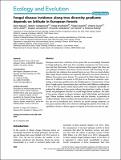Por favor, use este identificador para citar o enlazar a este item:
http://hdl.handle.net/10261/137922COMPARTIR / EXPORTAR:
 SHARE SHARE
 CORE
BASE CORE
BASE
|
|
| Visualizar otros formatos: MARC | Dublin Core | RDF | ORE | MODS | METS | DIDL | DATACITE | |

| Título: | Fungal disease incidence along tree diversity gradients depends on latitude in European forests |
Autor: | Nguyen, Diem; Castagneyrol, Bastien; Bruelheide, Helge; Bussotti, Filippo; Guyot, Virginie; Jactel, Hervé; Jaroszewicz, Bogdan; Valladares Ros, Fernando CSIC ORCID ; Stenlid, Jan; Boberg, Johanna | Palabras clave: | Diversity gradient Europe Foliar fungal pathogen Forests FunDivEUROPE Latitudinal gradient Tree species richness |
Fecha de publicación: | abr-2016 | Editor: | John Wiley & Sons European Society of Evolutionary Biology Society for the Study of Evolution |
Citación: | Ecology and Evolution 6(8): 2426–2438 (2016) | Resumen: | European forests host a diversity of tree species that are increasingly threatened by fungal pathogens, which may have cascading consequences for forest ecosystems and their functioning. Previous experimental studies suggest that foliar and root pathogen abundance and disease severity decrease with increasing tree species diversity, but evidences from natural forests are rare. Here, we tested whether foliar fungal disease incidence was negatively affected by tree species diversity in different forest types across Europe. We measured the foliar fungal disease incidence on 16 different tree species in 209 plots in six European countries, representing a forest-type gradient from the Mediterranean to boreal forests. Forest plots of single species (monoculture plots) and those with different combinations of two to five tree species (mixed species plots) were compared. Specifically, we analyzed the influence of tree species richness, functional type (conifer vs. broadleaved) and phylogenetic diversity on overall fungal disease incidence. The effect of tree species richness on disease incidence varied with latitude and functional type. Disease incidence tended to increase with tree diversity, in particular in northern latitudes. Disease incidence decreased with tree species richness in conifers, but not in broadleaved trees. However, for specific damage symptoms, no tree species richness effects were observed. Although the patterns were weak, susceptibility of forests to disease appears to depend on the forest site and tree type. | Versión del editor: | http://dx.doi.org/10.1002/ece3.2056 | URI: | http://hdl.handle.net/10261/137922 | DOI: | 10.1002/ece3.2056 | E-ISSN: | 2045-7758 |
| Aparece en las colecciones: | (MNCN) Artículos |
Ficheros en este ítem:
| Fichero | Descripción | Tamaño | Formato | |
|---|---|---|---|---|
| EcolEvol 6(8) 2426–2438 (2016).pdf | 378,29 kB | Adobe PDF |  Visualizar/Abrir |
CORE Recommender
PubMed Central
Citations
10
checked on 31-mar-2024
SCOPUSTM
Citations
40
checked on 23-abr-2024
WEB OF SCIENCETM
Citations
33
checked on 22-feb-2024
Page view(s)
266
checked on 24-abr-2024
Download(s)
247
checked on 24-abr-2024

